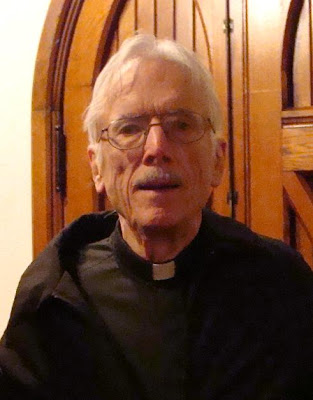Adieux.

Despite my sadness at Tom's passing, I found much consolation attending his wake and funeral this past weekend at Georgetown. The assembled mourners included many whom I count as old friends, including some I hadn't seen since my college graduation. Sharing our memories of Tom provided a means of affirming his continued presence among us in spite of the pain that we felt at his apparent absence. Having frequently enjoyed Father King's company at the "soirées" that often followed his 11:15 pm Mass, we expressed our confident hope that our dear friend now shares the company of the saints as a participant in what one eulogist at Saturday's funeral Mass called "the eternal soirée."
Of the various tributes to Tom King that have been published online in the last few days, two carry particular meaning for me. The first comes from Brenner Fissell, a 2009 graduate of Georgetown College, who offers some poignant reflections on Father King's life and death on his blog. Though I don't know Brenner personally, I share many of the sentiments that he expresses in this post, which I suggest you read in its entirety. Here's an excerpt:
[Father King] was a theologian, a man who spent his entire life plumbing the "same great depths" that the philosophers long had plumbed, a man who dealt constantly with those who doubted God's existence and yet maintained his strong faith. Now, this true lover of wisdom—this true philosopher—is united with wisdom itself, and his faith is confirmed. Knowing how Father King loved Teilhard's thought, I am sure that he viewed death as the ultimate communion, a privileged moment of man surmounting himself. Who could forget those memorable passages in [Teilhard's] Divine Milieu, passages King had ingrained in his own heart and mind. I wonder if he thought of them during those last moments.I believe that all who gathered in Dahlgren Chapel last Saturday to remember Tom King shared in this hope. I can affirm that I found the funeral liturgy to be, as Brenner Fissell describes it, "real, genuine, sincere. All of us were together as humans and as Georgetown. Everyone, even if just for that moment, was imbued with King’s humility. I have never before felt as strong a sense of community at this university as I did on that morning." Though I wouldn't have thought to put it that way myself, I completely agree.
I remember walking by him in the commencement procession and waving. He did not take part in all the pomp: he was just standing alone, watching from the main gates, a sincere smile on his face (one that we all remember well). Uncommon humility for Georgetown's "Man of the Millenium." The next day was the Baccalaureate mass, and Father King was just concelebrating on this occasion. Watching him walk down from the stage, the words of Ubi Caritas resounded in the background: "Where true love abides, God Himself is there."
A few days later, I had lunch with Father King at the Jesuit Residence. During most of the lunch, we discussed Plato and his own interpretations—Plato was, next to Teilhard, King’s favorite. As I turned to say goodbye at the door, he handed me a prayer card he had made up for his 40th anniversary at Georgetown. I said to him, “I hope to see you again,” and that was the last time I saw him alive (about one month ago). Father King always recognized the significance of the present moment, and I have no doubt that he viewed those words as much more than a mundane expression one might vomit out unthinkingly as he says goodbye. Hope. Resurrection. All these subconsciously permeated such words. I hope to see you again.
It’s amazing that he is no longer with us in the way we’ve known and loved him. What’s almost as amazing is that this isn’t the lead headline of every newspaper. I wish everyone had the chance to know him. I want to shout to the world—this is how we’re meant to live!As fine as these words are, the most moving tribute that I've seen paid to Tom King in the past week didn't involve words at all. On Saturday, Tom's coffin was carried into Dahlgren Chapel and later borne to the grave by several current Georgetown undergraduates. I can't imagine a more heartfelt gesture of thanks from the last group of Hoyas to have known this dearly beloved and truly legendary Georgetown Jesuit. As one who is deeply grateful to have known Tom King, I can only regret that future generations of Hoyas will not have the same pleasure. Goodbye, Tom. I hope to see you again. AMDG.
He was eighty years old but what a lie that feels. Tom was a rare bird in every way, including his genuine timelessness. In his eyes one could see a soul of perpetual youth—alive and ignited by unquenchable whimsy, intelligence and enchantment. I think if I had to name the single characteristic I found most appealing in him, it was his enchantment with existence and the divinity he saw shimmering within it.
. . .
Whatever good has become of me, were you to go to the heart of it, you’d glimpse Thomas Mulvihill King. Teacher, brother, precious friend, be with us in prayer and pray for us in God’s Kingdom, that we may all be united with you there.












